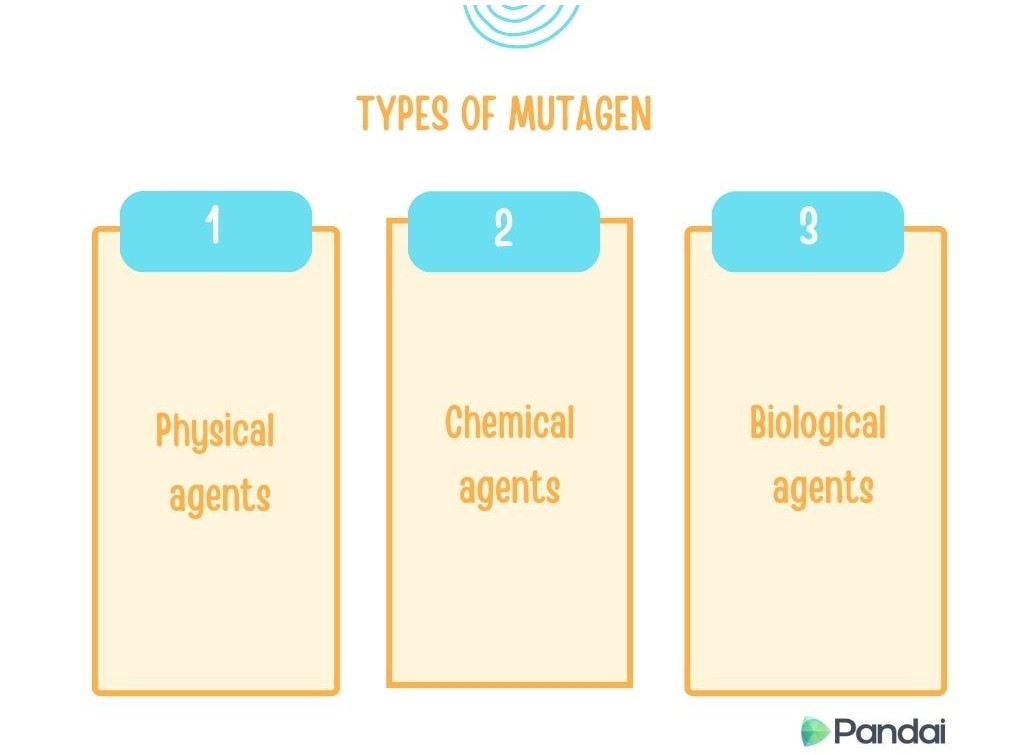| |
|
|
| |
| Definition of Mutation |
| A spontaneous and random change of genetic material, namely DNA of the cell in an organism. |
|
| |
| Mutagen |
| A substance which causes mutation or increases the mutation rate to a dangerous level. |
|
| |
| Process of Mutation |
| Mutation occurs spontaneously in natural conditions. |
|
| |
| Mutant |
- New genetic material produced by mutation is called a mutant.
- A mutant can exist as mutant gene, mutant cell, mutant organelle or mutant individual.
|
|
| |
 |
| |
| Types of Mutagen |
- Ultraviolet from the sun.
- Ionising rays such as X-ray, alpha ray and beta ray.
|
- Carcinogen in cigarette smoke.
- Food preservatives.
- Formaldehyde.
- Benzene.
|
|
|
|
| |
| Types of Mutations |
- Gene mutations occur when there is a change in the nucleotide base sequence in a gene.
- Gene mutations are also known as point mutations.
- These changes alter the genetic code used for amino acid synthesis.
- As a result, the structure of the produced protein changes and the new protein synthesized is unable to function.
- Gene mutations occur through base replacement, base deletion and base insertion.
- Gene mutations cause genetic diseases such as thalassemia, cystic fibrosis, sickle cell anemia, albinism and hemophilia.
-
- Sickle cell anemia:
- Sickle cell anaemia is caused by a gene responsible for the synthesis of haemoglobin.
- The red blood cells of a patient are in the shape of a crescent.
- This is because the red blood cells are not properly formed.
- Some red blood cells are normal whereas the rest are crescent shape.
- Albinism:
- An individual who experiences albinism is an albino.
- Albinism is due to the mutation of a gene which is responsible for producing pigments of skin, hair and eyes.
- Hence, the pigments are not produced in the albino.
- Example of genetic disease is as shown below:
| Types of Gene Mutation |
Examples of Disease |
| Base substituition |
Sickle cell anaemia |
| Base insertion |
Cystic fibrosis |
| Base deletion |
Thalasemia |
|
- Chromosomal mutations involve changes in the structure of chromosomes or changes in the number of chromosomes.
- Chromosomal mutations can cause characteristic changes in an organism.
- Changes in chromosomal structure involve changes in the arrangement of genes on a chromosome.
- Changes in the structure of chromosomes cause abnormalities in those chromosomes.
- This condition of abnormality is called chromosomal aberration.
- Types of chromosomal aberration:
- Deletion:
- A part or a segment of chromosome is deleted or lost (loss of a few genes).
- DuplicationPenggandaan:
- A part of a chromosome is copied which causes repetition of gene sequence.
- Inversion:
- A segment of chromosome is reversed end to end at 180o then rejoin (change in DNA sequence of chromosome).
- Translocation:
- Part of the chromosome is cut, then join to another non-homologous chromosome.
- A change in chromosomal number causes a diploid organism to lose one or more chromosomes, or gain one or more chromosomes.
- The change occurs when homologous chromosomes fail to separate during anaphase I in meiosis or sister-chromatids fail to separate during anaphase II in meiosis.
- This is probably because the normal spindle fibres fail to form during meiosis.
- Abnormality in the number of chromosomes can be due to nondisjunction during spermatogenesis or oogenesis.
- Fertilisation that involves abnormal gametes will produce a zygote that develops into an individual with abnormal characteristics.
- The individual experiences change in phenotype
|
|
| |
| Characteristics of Diseases Caused by Chromosome Mutation |
| Abnormalities in Autosomes |
| Diseases |
Chromosome Number |
Characteristics of Diseases |
| Down Syndrome |
- (2n + 1) = 47.
- Has three number 21 chromosomes.
|
- An individual (male or female) has slant eyes, flat nose, protruding tongue, broad forehead and is usually mentally retarded.
|
| Cri du chat syndrome |
- The structure of chromosome changes due to a partial deletion on the short arm of chromosome number 5.
|
- The cry of affected infants is similar to that of a meowing kitten.
- Affected individual shows delayed development with mental and physical retardation.
- Most patients die during childhood.
|
| Abnormalities in Sex Chromosomes |
| Klinefelter Syndrome |
|
- A sterile man with small testes that fail to produce sperms.
- Possesses voice and chest similar to those of a woman.
- Has long legs and hands
|
| Jacob Syndrome |
|
- Male who is taller than normal and has problem with pimples on his face.
- Slow in acquiring speech and has learning disability.
- Possesses weak muscles (hypotonia).
|
| Turner Syndrome |
|
- Sterile female with lack of secondary female characteristics, undeveloped breasts and ovaries.
- Weblike neck and low IQ.
|
|
| |
| Mutation of Somatic Cells and Gametes |
- Mutation can occur in somatic cells and gametes to produce variation in a population.
- The table below shows the differences between mutation in somatic cells and gametes.
|
|
| |
| Mutation in Somatic Cells |
Mutation in Gametes |
| Involves somatic cells such as skin cell and eye cell. |
Involves germ cell that produces gamete (secondary oocyte or sperm). |
| Cannot be inherited by the next generation. |
Can be inherited by the next generation. |
| Disease is present only in the individual with the mutation. |
Disease is present in the individual with the mutation and is also inherited by his/her descendants. |
| Example: Disease related to nervous system. |
Example: All inherited diseases such as thalassemia. |
|
| |